NavSource Online: Submarine Photo Archive
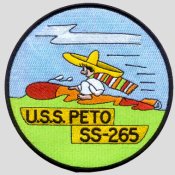
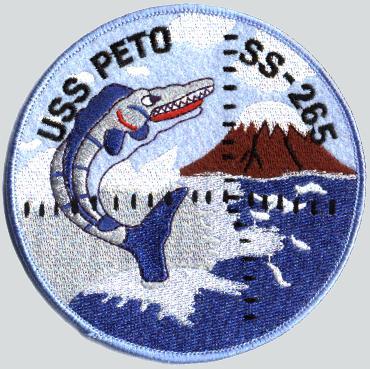
Patch at left contributed by Harold F.(Carl) Carlson, on right by Mike Smolinski
Please report any broken links or trouble you might come across to the Webmaster.
Please take a moment to let us know so that we can correct any problems and make your visit as enjoyable and as informative as possible.


| Click On Image For Full Size | Size | Image Description | Source | |
|---|---|---|---|---|
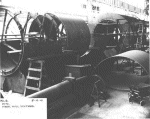 | 78k | Interior hull sections of the Peto (SS-265), 4 May 1941. The building where the sub sections were fitted together is not the building ways but is the spot where the sections are welded up before removing them to the building ways. The sections are upside down in the building and are turned right-side up before taking outside. | Editors Note: There are over 200 images submitted on these pages covering the following submarines that were constructed at the Manitowoc Shipbuilding Co, Manitowoc, WI,: SS-265 through SS-274, and SS-361 through SS-380. None of them would have seen the light of day if it were not for the efforts of former Curator, Asst. Director, Bill Thiesen of the Wisconsin Maritime Museum Larry Bohn, Caitlin Clyne, Rolf Johnson & Susan Menk who sent them to NavSource for publication. A special debt of gratitude is owed to them and the Wisconsin Maritime Museum, home of the Cobia (SS-245), for allowing these photographs to be seen by the lovers of naval history worldwide. | |
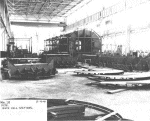 | 106k | Interior hull sections of the Peto (SS-265), 4 May 1941. | Photo by Harry Berns, Official photographer of the Manitowoc Shipbuilding Co., Manitowoc, WI. Submitted by Larry Bohn, courtesy of the Wisconsin Maritime Museum, home of the Cobia (SS-245). | |
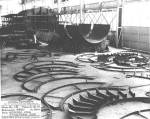 | 106k | General view of the structural shop where the Peto's (SS-265) first sections were put together, 18 May 1941. | Photo by Harry Berns, Official photographer of the Manitowoc Shipbuilding Co., Manitowoc, WI. Submitted by Larry Bohn, courtesy of the Wisconsin Maritime Museum, home of the Cobia (SS-245). | |
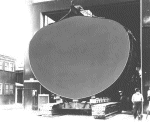 | 63k | Censored photo of the hull section of the Peto (SS-265), being brought out of the structural shop. | Photo by Harry Berns, Official photographer of the Manitowoc Shipbuilding Co., Manitowoc, WI. Submitted by Larry Bohn, courtesy of the Wisconsin Maritime Museum, home of the Cobia (SS-245). | |
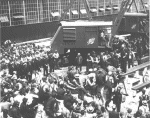 | 83k | Human interest story: Navy and shipyard personel take a break to watch the laying down of the first section of the Peto (SS-265), being brought out of the structural shop. | Photo by Harry Berns, Official photographer of the Manitowoc Shipbuilding Co., Manitowoc, WI. Submitted by Larry Bohn, courtesy of the Wisconsin Maritime Museum, home of the Cobia (SS-245). | |
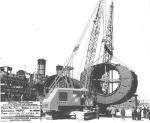 | 84k | "Speed Cranes" lifting Section H of the Peto (SS-265), into place 21 June 1941. The ship alongside this berth is the passenger boat SS Theodore Roosevelt which was laid up at the yard all during WWII. It was used to hide goings on from possible prying eyes. Note: The "Speed Cranes" were designed and built by the shipyard specifically to handle the Submarine Sections. At the time they were about the biggest capacity crawler cranes built. The design later became the standard 3900 model produced by Manitowoc Co. and was one of their most popular models until superseded by heavier models. | Photo by Harry Berns, Official photographer of the Manitowoc Shipbuilding Co., Manitowoc, WI. Submitted by Larry Bohn, courtesy of the Wisconsin Maritime Museum, home of the Cobia (SS-245). | |
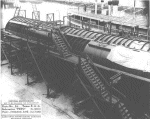 | 94k | Forward end sections of the Peto (SS-265), 10 August 1941. | Photo by Harry Berns, Official photographer of the Manitowoc Shipbuilding Co., Manitowoc, WI. Submitted by Larry Bohn, courtesy of the Wisconsin Maritime Museum, home of the Cobia (SS-245). | |
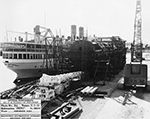 | 170k | Peto (SS-265) under construction at Manitowoc Shipbuilding Company in Manitowoc, Wisconsin in September, 1941. Several hull sections are on the building ways next to the passenger steamship SS Theodore Roosevelt. | Photo by Harry Berns, Official photographer of the Manitowoc Shipbuilding Co., Manitowoc, WI. Submitted by Larry Bohn, courtesy of the Wisconsin Maritime Museum, home of the Cobia (SS-245) |
|
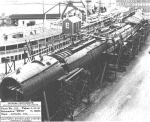 | 125k | Forward end of the Peto (SS-265), 30 November 1941. | Photo by Harry Berns, Official photographer of the Manitowoc Shipbuilding Co., Manitowoc, WI. Submitted by Larry Bohn, courtesy of the Wisconsin Maritime Museum, home of the Cobia (SS-245). | |
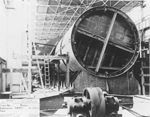 | 68k | Peto (SS-265), hull section under construction, circa late 1941. | Photo by Harry Berns, Official photographer of the Manitowoc Shipbuilding Co., Manitowoc, WI. Submitted by Larry Bohn, courtesy of the Wisconsin Maritime Museum, home of the Cobia (SS-245). | |
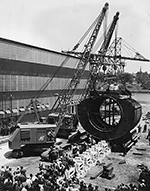 | 244k | Peto (SS-265), hull section under construction, circa late 1941. | Photo by Harry Berns, Official photographer of the Manitowoc Shipbuilding Co., Manitowoc, WI. Submitted by Larry Bohn, courtesy of the Wisconsin Maritime Museum, home of the Cobia (SS-245). | |
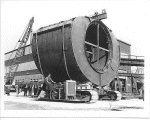 | 73k | Peto (SS-265), transporting a section of the hull during her construction, circa late 1941. This is typical of U.S. double hull construction, with tank-age wrapped completely around the circular-section pressure hull. The ends of such a "fleet boat" were single hull because it was difficult to get into very narrow tanks to maintain them and the pressure hull inside. | Submitted by Larry Bohn, courtesy of the Wisconsin Maritime Museum, home of the Cobia (SS-245) . Text courtesy of U.S. Submarines Through 1945, An Illustrated Design History by Norman Friedman. Naval Institute Press. | |
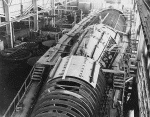 | 102k | Hull section of the Peto (SS-265), under construction, circa mid November, 1941. | Submitted by Larry Bohn, courtesy of the Wisconsin Maritime Museum, home of the Cobia (SS-245. | |
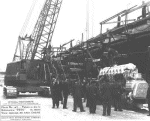 | 91k | The first engine of the Peto (SS-265), is hoisted aboard, 29 December 1941. | Photo by Harry Berns, Official photographer of the Manitowoc Shipbuilding Co., Manitowoc, WI. Submitted by Larry Bohn, courtesy of the Wisconsin Maritime Museum, home of the Cobia (SS-245). | |
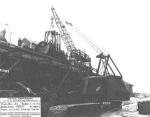 | 59k | Setting the conning tower of the Peto (SS-265), 19 January 1942. | Photo by Harry Berns, Official photographer of the Manitowoc Shipbuilding Co., Manitowoc, WI. Submitted by Larry Bohn, courtesy of the Wisconsin Maritime Museum, home of the Cobia (SS-245). | |
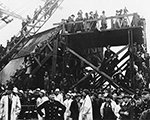 | 209k | Peto (SS-265) about to be launched, 11:47 a.m. on 30 April 1942. | Photo by Harry Berns, Official photographer of the Manitowoc Shipbuilding Co., Manitowoc, WI. Submitted by Larry Bohn, courtesy of the Wisconsin Maritime Museum, home of the Cobia (SS-245) |
|
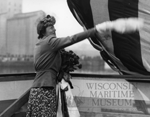 | 183k | Mrs. Emanual A Lofquist, Peto's (SS-265) sponsor, breaking the champagne bottle on bow at launch from berth A on 30 April 1942. (elevator A in background). | Photo by Harry Berns, Official photographer of the Manitowoc Shipbuilding Co., Manitowoc, WI. Submitted by Susan Menk, Archives Assistant, Manitowoc Shipbuilding Co., Manitowoc, WI. This photo, # 2001-1-263, can be ordered (without the watermark) from the Wisconsin Maritime Museum. | |
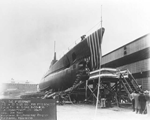 | 255k | Peto (SS-265), on the ways getting ready for launching 30 April 1942. | Photo by Harry Berns, Official photographer of the Manitowoc Shipbuilding Co., Manitowoc, WI. Submitted by Larry Bohn, courtesy of the Wisconsin Maritime Museum, home of the Cobia (SS-245). | |
 | 350k | Peto (SS-265), side launching at a 48 degree angle at Manitowoc Shipbuilding Co, Manitowoc, WI. 30 April 1942. "The boat had been built on the building ways, consisting of a set of wooden blocks in a horizontal line and parallel to the face of the sea wall. After the sections were placed on these blocks a cribbing, or supporting structure, was erected to support the sections in place and to prevent movement. As the date for the launch approached the workers constructed a second set of ways. These launching ways were at right angels to the sea wall and extended inboard under the boat. They were massive fur timbers, 16" x 24", placed about 14" apart and supported by cribbing of a size and strength to support the weight of the boat during the launch. The launching was sloped down toward the seawall at an angle of 1 and 19/32" per horizontal foot. For the launch of a submarine, a total of 21 launching ways were used. All except the forward and after three extended 12' past the sea wall, and were capable of tilting when the submarine went over the sea wall. This was to eliminate the possibility of damage to the vessel's structure and to the launch-ways at the moment when the boat pivoted at the dock's edge. The forward and after three ways were known as the fixed ways and extended only to the sea wall and did not tilt. They were firmly fixed in place to take the full horizontal thrust of the vessel just prior to launch. The trigger was held in place by means of a trigger line, an 8" manila line was set up with a block and tackle to a fixed point, a dead-man or other fitting, inboard of the vessel. Sliding ways were placed on the launching ways and on these were built the launching cradles. The cradles were built to confirm to the shape of the hull and were constructed so as to be as snug as possible to the hull. Between individual pieces of the cradles were inserted oak wedges, so positioned as to be readily accessible for driving by hand. The trigger lines were cut at the moment of launch by means of pneumatic rope cutters or guillotines containing a piston attached to a cutting knife and actuated by compressed air from a central master valve. They were so calibrated that air reached each cutter at precisely the same instant." | Text from Fresh Water Submarines, The Manitowoc Story,. pg 43-44, by Rear Admiral William T. Nelson, U.S.N. (Ret.) Photo by Harry Berns, Official photographer of the Manitowoc Shipbuilding Co., Manitowoc, WI., courtesy of Scott Koen & ussnewyork.com. |
|
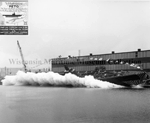 0826551 | 438k | Starboard side view of the launching splash of the Manitowoc built submarine Peto (SS-265) at Manitowoc Shipbuilding Company on 30 April 1942. Center block insignia in corner of photo. | This photo, # P90-9-2, can be ordered (without the watermark) from the Wisconsin Maritime Museum. | |
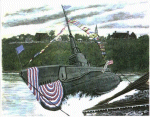 | 55k | Watercolor print by the artist Tom Denton of the side launching of a Manitowoc built boat. | Courtesy of Submarine Art | |
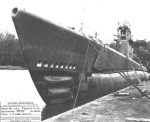 | 80k | Fitting berth of the Peto (SS-265), 4 days after her launching, 3 May 1942. | Photo by Harry Berns, Official photographer of the Manitowoc Shipbuilding Co., Manitowoc, WI. Submitted by Larry Bohn, courtesy of the Wisconsin Maritime Museum, home of the Cobia (SS-245). | |
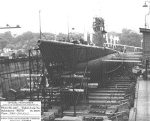 | 59k | The Peto (SS-265), in drydock, 26 July 1942. | Photo by Harry Berns, Official photographer of the Manitowoc Shipbuilding Co., Manitowoc, WI. Submitted by Larry Bohn, courtesy of the Wisconsin Maritime Museum, home of the Cobia (SS-245). | |
 | 24k | Commemorative post mark on the occasion of the Peto's (SS-265) commissioning, 21 November 1942, at Manitowoc. | Courtesy of petloveshack.com. | |
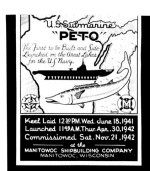 | 47k | Peto (SS-265), commemorative emblem detailing the ship's history as the first submarine to be built and side launched at Manitowoc Shipbuilding Co, Manitowoc, WI. 21 November 1942. | Photo by Harry Berns, Official photographer of the Manitowoc Shipbuilding Co., Manitowoc, WI. Submitted by Larry Bohn, courtesy of the Wisconsin Maritime Museum, home of the Cobia (SS-245) | |
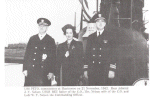 | 92k | Peto (SS-265), commissions at Manitowoc Shipbuilding Co, Manitowoc, WI. 21 November 1942. Rear Admiral J. T. Nelson USNR, Ret, father of the C.O., Mrs. Nelson, wife of the C.O. and Lcdr W.T. Nelson, the C.O. | Photo by Harry Berns, Official photographer of the Manitowoc Shipbuilding Co., Manitowoc, WI. Submitted by Larry Bohn, courtesy of the Wisconsin Maritime Museum, home of the Cobia (SS-245) | |
 | 156k | Peto (SS-265), returning to Manitowoc Shipbuilding Co, Manitowoc, WI. November 1942 after first day of trials under trial crew of Electric Boat Company. | Photo by Harry Berns, Official photographer of the Manitowoc Shipbuilding Co., Manitowoc, WI. Submitted by Larry Bohn, courtesy of the Wisconsin Maritime Museum, home of the Cobia (SS-245) | |
 | 136k | Peto (SS-265), plank-owners at commissioning ceremony salute the colors, 21 November 1942. | Photo by Harry Berns, Official photographer of the Manitowoc Shipbuilding Co., Manitowoc, WI. Submitted by Larry Bohn, courtesy of the Wisconsin Maritime Museum, home of the Cobia (SS-245) | |
 | 102k | Peto (SS-265) commissioning party. | Photo submitted by Larry Bohn, courtesy of the Wisconsin Maritime Museum, home of the Cobia (SS-245). | |
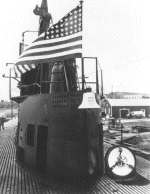 | 81k | Peto (SS-265), conning tower and ship's bell, November 1942. | Photo by Harry Berns, Official photographer of the Manitowoc Shipbuilding Co., Manitowoc, WI. Submitted by Larry Bohn, courtesy of the Wisconsin Maritime Museum, home of the Cobia (SS-245) | |
 | 182k | Peto (SS-265), starboard view on her way for sea trials on Lake Michigan, November 1942. | Photo by Harry Berns, Official photographer of the Manitowoc Shipbuilding Co., Manitowoc, WI. Submitted by Larry Bohn, courtesy of the Wisconsin Maritime Museum, home of the Cobia (SS-245) | |
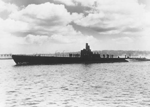 | 30k | Peto (SS-265), leaving dockside on her way for sea trials on Lake Michigan, November 1942. | Photo by Harry Berns, Official photographer of the Manitowoc Shipbuilding Co., Manitowoc, WI. Submitted by Larry Bohn, courtesy of the Wisconsin Maritime Museum, home of the Cobia (SS-245) | |
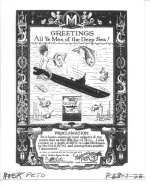 | 100k | Calling card of the Peto (SS-265) while she dove for depth tests in Lake Michigan, 8 November 1942. | Photo by Harry Berns, Official photographer of the Manitowoc Shipbuilding Co., Manitowoc, WI. Submitted by Larry Bohn, courtesy of the Wisconsin Maritime Museum, home of the Cobia (SS-245) | |
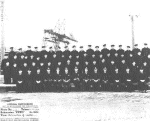 | 48k | Officers and crew of the Peto (SS-265), December 1942. | Photo by Harry Berns, Official photographer of the Manitowoc Shipbuilding Co., Manitowoc, WI. Submitted by Larry Bohn, courtesy of the Wisconsin Maritime Museum, home of the Cobia (SS-245) | |
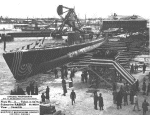 | 108k | Rasher (SS-269), has just been docked after launching, 20 December 1942. The sub in the background is the Peto (SS-265), which will be decommissioned on Christmas Day and taken to New Orleans for recommissioning. | Photo by Harry Berns, Official photographer of the Manitowoc Shipbuilding Co., Manitowoc, WI. Submitted by Larry Bohn, courtesy of the Wisconsin Maritime Museum, home of the Cobia (SS-245) | |
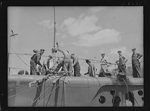 | 78 k | RADIOPHOTO CHICAGO BUREAU, MID-WEST BUILT SUBMARINE ON WAY TO THE SEA; The Peto (SS-265), first U.S. Navy submarine built on the Great Lakes, arrives at Lockport, IL after a trip down Lake Michigan and through The Chicago Drainage Canal and Illinois Waterway, from the shipyards at Manitowoc, Wis. The sub was placed in drydock to be towed the balance of the trip through the Illinois and Mississippi Rivers to New Oreleans LA, where it will receive its final fitting. | Official USN photo from ACME courtesy of the MacArthur Museum of Arkansas Military History and submitted by Bill Gonyo. Newspaper article courtesy of Ron Reeves (of blessed memory). |
|
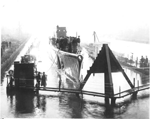 | 244k | In order to deliver the subs to New Orleans, the equipment above the conning tower had to be removed and secured on deck to enable the sub to pass under a bridge in the Chicago river. The sub was then mounted on a floating drydock to get it through the shallow areas in the Mississippi river. The Peto (SS-265) is being placed in the drydock on a cold day in Lockport, Illinois 26 December 1942, in preparation for the move south. In early January, because of the rise of the waters in Illinois the Peto was tied up to a willow tree near a cornfield in Morris, Illinois for a week. | Photo by Harry Berns, Official photographer of the Manitowoc Shipbuilding Co., Manitowoc, WI. Submitted by Larry Bohn, courtesy of the Wisconsin Maritime Museum, home of the Cobia (SS-245) | |
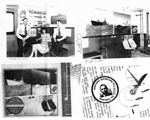 | 485k | Photo of Harry Berns, Official photographer of the Manitowoc Shipbuilding Co., Manitowoc, WI. The photo of the Golet (SS-361) encased in snow appears on the wall above him on the upper right. His obituary appears here. | Photo courtesy of Susan Menk, Archives Assistant, Wisconsin Maritime Museum, Dee Anna Grimsrud,Reference Archivist, Wisconsin Historical Society, Steve Khail, CBC, Director of Investor Relations & Corporate Communications, The Manitowoc Company, Inc. & William Young. | |
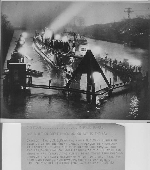 | 105k | RADIOPHOTO CHICAGO BUREAU, MID-WEST BUILT SUBMARINE ON WAY TO THE SEA; The Peto (SS-265), the first U.S. Navy submarine ever built on the Great Lakes, is placed in a drydock at Lockport, IL for the trip to New Orleans, LA and the sea, over shallow lower reaches of the Illinois and Mississippi Rivers. The sub is being towed from Chicago through the inland waterways after tests and trial run from Manitowoc, Wis. Shipyards, where it was built. | Official USN photo from ACME courtesy of the MacArthur Museum of Arkansas Military History and submitted by Bill Gonyo. | |
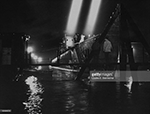 | 655k | Peto (SS-265) easing in to the dock. | Photo by Charles E. Steinheimer/The LIFE Picture Collection/Getty Images courtesy of gettyimages.com. | |
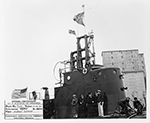 | 119k | Clean sweep on the Peto (SS-265) following her preliminary trials on 16 November 1942. | Photo by Harry Berns, Official photographer of the Manitowoc Shipbuilding Co., Manitowoc, WI. Submitted by Larry Bohn, courtesy of the Wisconsin Maritime Museum, home of the Cobia (SS-245) |
|
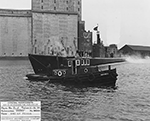 | 186k | Starboard side view of the tug Manshipco and a 3/4 port side view of the submarine Peto (SS-265) as the tug tows the Peto (SS-265) up the Manitowoc River back to the Manitowoc Shipbuilding Company shipyards. The tug is starting to turn the submarine in preparation for its return to the building berth. | Photo by Harry Berns, Official photographer of the Manitowoc Shipbuilding Co., Manitowoc, WI. Submitted by Larry Bohn, courtesy of the Wisconsin Maritime Museum, home of the Cobia (SS-245) |
|
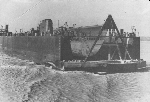 | 83k | The Peto (SS-265) in a floating dock, being pushed by a tug Kansas City of the Federal Barge Lines. Note her periscopes and masts have not yet been installed, to permit passage under low bridges. | USN photo from "The American Submarine" by Norman Polmar, courtesy of Robert Hurst. | |
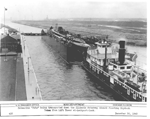 | 285k | The Peto (SS-265) on the first day of her trip down river, 26 December 1942. The tug is the Kansas City of the Federal Barge Lines. | Submitted by Bob Peppard, courtesy of the Wisconsin Maritime Museum, home of the Cobia (SS-245) | |
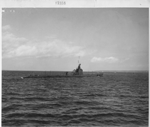 | 2.40k | The boat in question is a Mod 2A Gato of the EB design. She still has the covered navigation bridge (but it is the post-Guardfish (SS-217) short version), and the cigarette deck bulwark has been cut away and a 20mm gun with the solid Mk 5 mount has been added. This boat also has the "thick scope" variation, meaning that in addition to removing the plating from around the shears, the scope tubes have been beefed up to prevent vibration at periscope depth. The photo was taken in late 1942 or very early 1943. Based on analysis of other photos, this can only be one of six boats: Guardfish, Albacore (SS-218), Amberjack (SS-219), Barb (SS-220), Blackfish (SS-221), or Peto (SS-265). I am leaning heavily towards this boat being the Peto. Peto was built in Manitowoc to the EB design, then was barged down the Mississippi River and put back in the water in New Orleans. This pic may very well have been taken in the Gulf of Mexico after they put her back in the water and reinstalled the scopes. They would have conducted a short sea trial to verify everything was working properly after the long barge trip down river. My guess as to the location was just that, a guess. It could very well be in Lake Michigan. Looking closer at the photo she is sitting kind of low in the water and no one seems to be topside. This photo may have been taken just after surfacing and before or right after they started the low pressure blowers to bring her to full surface trim. It is hard to tell, but it also looks like the bow planes are still rigged out. There is a small wake right about were they would be, and the recesses in the superstructure where they fold up into appear to be open. The small circular antenna at the aft end of the bridge fairwater is a Low Frequency (LF) loop that allowed radio reception at periscope depth. The thin semi-circular "antenna" above the LF loop attaches at two points to the railing on the aft end of the lookout platforms then bends around to attach to the LF mast itself. My first thought was that it was nothing more than a guard railing for the LF antenna. But then I asked myself, what is it guarding against? Your explanation of it being a whip antenna could also be true. The Government design boats had it as well. There seems to be several different variations on this feature, even amongst the EB design boats. I will have to look into this some more. | US National Archives photo # 80G-17358 from NARA, College Park, Maryland, courtesy of Sean Hert. Photo & text i.d. courtesy of David Johnston (USN, retired) , John Hart. | |
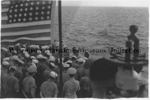 0826549 | 374k | Commander William T. Nelson addressing the crew of Peto (SS-265) at completion of the Second Patrol in Brisbane, Australia, 4 August 1943. View looking down on men standing on deck with American flag in foreground. | This photo, # P71-64-12, can be ordered (without the watermark) from the Wisconsin Maritime Museum. | |
 0826550 | 267k | Crew member of the Manitowoc-built submarine Peto (SS-265) on top of conning tower after the Peto's second patrol with the submarine's new battle flag showing symbols of a white mask and the setting sun. | This photo, # P71-64-11, can be ordered (without the watermark) from the Wisconsin Maritime Museum. | |
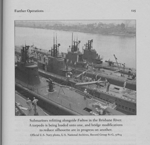 |
640k | Photo caption reads: Submarines refitting alongside Fulton (AS-11) in the Brisbane River. A torpedo is being loaded onto one, and bridge modifications to reduce silhouette are in progress on another. Boat #1: Grouper (SS-214), Boat #2: Peto (SS-265), Boat #3: Scamp (SS-277), Boat #4: Albacore (SS-218), Boat #5: Drum (SS-228), 4-7 June, 1943. EB plan 2053-29, and BuShips plan 388778. Its a general outboard arrangement for SS-214-221 and SS-253-254. It shows very plainly that boats from SS-214 onwards only had the one small boat locker. Grouper only had the one small boat locker offset to port, but she carried the bulge to starboard as if she had one there too, only she didn't! The plan very clearly shows the bulge to starboard for Grouper, but then states, "DECKLINE FOR SS-214 ONLY." Grouper being modified with her bridge being cut down after her May 29 return from patrol with a high fairwater as in the US Subs Down Under photo, which would explain the whitish look to her bridge face; it was probably primer or wet paint. The bulge to starboard that I originally thought indicated either Gato (SS-212) or Greenling (SS-213) is there, but there just isn't any locker beneath it! Why EB built Grouper like this is anyone's guess. Perhaps when the change order came, construction on Grouper was already too far ahead to stop and re-contour the deck casing? EB wasn't known for deviating from the plans lightly, so perhaps this was the best the Navy could get out of them? They then went to the single locker and no starboard bulge of any kind starting with Growler (SS-215). This might explain why the Manitowoc boats had the single locker, too, since their contract was to build copies of Growler herself, portholes in the bridge face notwithstanding. EB initially resisted pressure from the Navy to alter the plans, citing concerns about delays in production if they did. What they were really worried about was making a profit, each little change cost more and ate into their profit margin. This attitude was somewhat understandable, as EB is a civilian company and they existed to make a profit for their shareholders. However, EB's intransigence got so bad that the Bureau of Ships had to threaten the company with making them build the boats to the Government plans supplied by Portsmouth, wiping out their design capability, which would have put them in a very bad spot commercially after the war. EB backed off when they realized how serious the Bureau was. They took on a whole new attitude and their resistance to change quickly evaporated. What you are seeing with Grouper is an outgrowth of this situation. As part of an attempt to eliminate what the Bureau thought was "frivolous" peacetime equipment on the boats, an order was issued on 10 May 1942 to eliminate the motorboat. This was the official order that legitimized a practice that was already going on in the fleet. Many of the submarines beached the motorboat(s) between patrols as it became clear that they were just not needed anymore. Grouper was probably built with the original capacity of having two boats, as was the original intent for the Gato class. But she may have only gotten one boat when she was finished. Albacore's patrol report backs up her being Boat #4. It reads, in part, "Major items accomplished during refit - alteration of bridge superstructure for mounting additional 20 mm gun." This was for her refit between 27 May and 10 June, 1943, so the dates connect up nicely with the photo. Either way, the dates look solid, and the activity in the photo looks like a June, 1943, photo. Peto would depart on patrol on June 13th, so the boxes on her foredeck are probably supplies being loaded up. |
Photo i.d. & text courtesy of Robert Morgan & David Johnston Photo courtesy of Robert Morgan courtesy of US Subs Down Under, 1942-1945 by David Jones & Peter Nunan. |
|
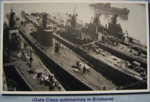 |
391k | The boats shown are all Gato's. Boat #1: Grouper (SS-214), Boat #2: Peto (SS-265), Boat #3: Scamp (SS-277), Boat #4: Albacore (SS-218), Boat #5: Drum (SS-228), 4-7 June, 1943. |
Photo i.d. & text courtesy of David Johnston Photo courtesy of Gerhard Mueller-Debus via Gary Priolo. |
|
 | 160k | Peto (SS-265), partially submerged while on war patrol, date and location unknown. | Photo by Harry Berns, Official photographer of the Manitowoc Shipbuilding Co., Manitowoc, WI. Submitted by Larry Bohn, courtesy of the Wisconsin Maritime Museum, home of the Cobia (SS-245) | |
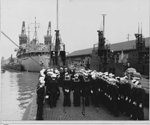 | 1.40k | Citation from Admiral Carpender aboard the Guardfish receiving their submarine combat insignia on 18 August 1943. The boats in the background are: Peto (SS-265) in the middle. Interesting that she still has the high bridge forward. She would depart on 9/1/43, so unless the tender did a quick cut down, she would have departed on patrol in September still with a high bridge. Even if they did cut it down before she departed, its interesting that she still had it as late as August. I had no idea they were splotching the periscopes that early, a great detail for modelers. Scamp (SS-277) to the right. Assuming the August 18 date is correct, that would match up. Scamp departed on patrol on September 2nd, so she would have been there. If the boat to her port is a high bridged type (hard to tell, but from the sailor peeking out of the dead light, maybe), then she would be Peto, who was likely the only high bridge type there, and probably the very last one. She would depart on September 2nd. Others in port at that time included Albacore (SS-218), Stingray (SS-186), Grouper (SS-214) and likely Gato (SS-212). All departed Brisbane between August 23rd and September 6th. Grouper is to the left in the background moored with the Fulton (AS-11). The boat to her starboard whose extreme stern is probably Tuna (SS-203). She had left for patrol before the awards ceremony date, but a friendly fire incident with an RAAF bird forced her back into Brisbane for repairs, so she had reentered port and didnít leave again until 21st August 1943. She had the aft torpedo tube shutters as-built like the other Tambors, and like the mystery boat. Itís hard to see and faint but the mystery boat appears to have the degaussing circuit on her stern. So did Tuna (http://www.navsource.org/archives/08/0820306.jpg), and at that precise place and time, too. | Majority text i.d. courtesy of Robert Morgan, with input from David Johnston (USN, retired) & John Hummel, USN (Retired). US National Archives photo # 80-G-394390 & 80-G-394401 from National Archives and Records Administration (NARA), College Park, Maryland, courtesy of Sean Hert. |
|
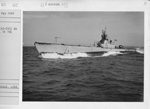 | 7.89k | Eleven photo PDF of the Peto (SS-265) underway off Pearl Harbor, circa 1944-45. On 29 September 1943 Peto sailed westward again, reached Pearl Harbor 7 October, and arrived Midway Island 27 October...... arrived at Guam 6 December 1944 and underwent a refit before sailing for Pearl Harbor where she arrived 2 January 1945. Peto departed from Pearl Harbor in company with submarines Thresher (SS-200), Shad (SS-235), and Tilefish (SS-307) 31 January, topped off at Saipan 12 February, and headed for her patrol area the following day. The caption on several of the photos on the side says "In training exercise off Pearl Harbor about 1944. Number on conning tower is for recognition during training only. Was painted out before going on patrol". | Text courtesy of DANFS. US National Archives photos # 80-G-468 126 / 468140 thru 468148 from NARA, College Park, Maryland, courtesy of Sean Hert. Photo i.d. courtesy of David Johnston (USN, retired) | |
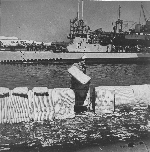 | 396k | This looks like the Peto (SS-265) at Midway, where she was between 9 April and 4 May 1945. The submarine tender behind her is probably Aegir (AS-23) which was also at Midway at the time. The Quonset huts of Midway submarine base appear to the left and above Peto. This photo was dated for release on 22 July, when Peto was conducting her final war patrol of World War II. The caption was about airing submarine bedding, and Peto was not referred to by name. The submarine in the forground where the sailor is airing bedding is not identified either. Close examination of the photo shows that the 40mm single gun forward on the conning tower has been censored out and a poor job of drawing in railings was done (which extends past the gun sponson!). | Official USN photo file # TR-15131-C. Photo courtesy of David Buell. |
|
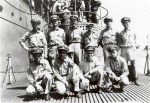 | 82k | Capt and officers of Peto (SS-265) at Guam 1945 with rescued New Zealand pilot Derick Morten. | Photo courtesy of John Hummel, USN (Retired). | |
 | 61k | WW II battle-flag of the of Peto (SS-265). | Courtesy of Jack Treutle (of blessed memory). | |
| Back To The Main Photo Index | Back To the Submarine Index |
| Problems and site related matters, E-mail Webmaster |
| This page is created by Gary Priolo and maintained by Michael Mohl All Pages © 1996 - 2023, NavSource History All rights reserved. |